We arranged to fly to Prague two days before our tour began due to the flight schedule, which originally had us arriving late in the evening of the first day, therefore missing out on the first full day in Prague, and Jane doesn't like to miss out on anything. While on our own we were able to do things that we otherwise would have missed...like being caught in a gully washer of a rain storm and getting soaked while eating at an outdoor cafe. We knew exactly where our umbrellas were - back in our hotel room. Again this year we were in Europe during a heat wave. As on previous trips, I released
Bookcrossing books along the way.
During the reign of Charles IV, King of Bohemia and Moravia, Prague was the seat of the Holy Roman Empire, and later was the center of the Hapsburg. Prague survived World War II virtually intact, unlike many other capitals of Europe. Prague became one of our favorite European cities.
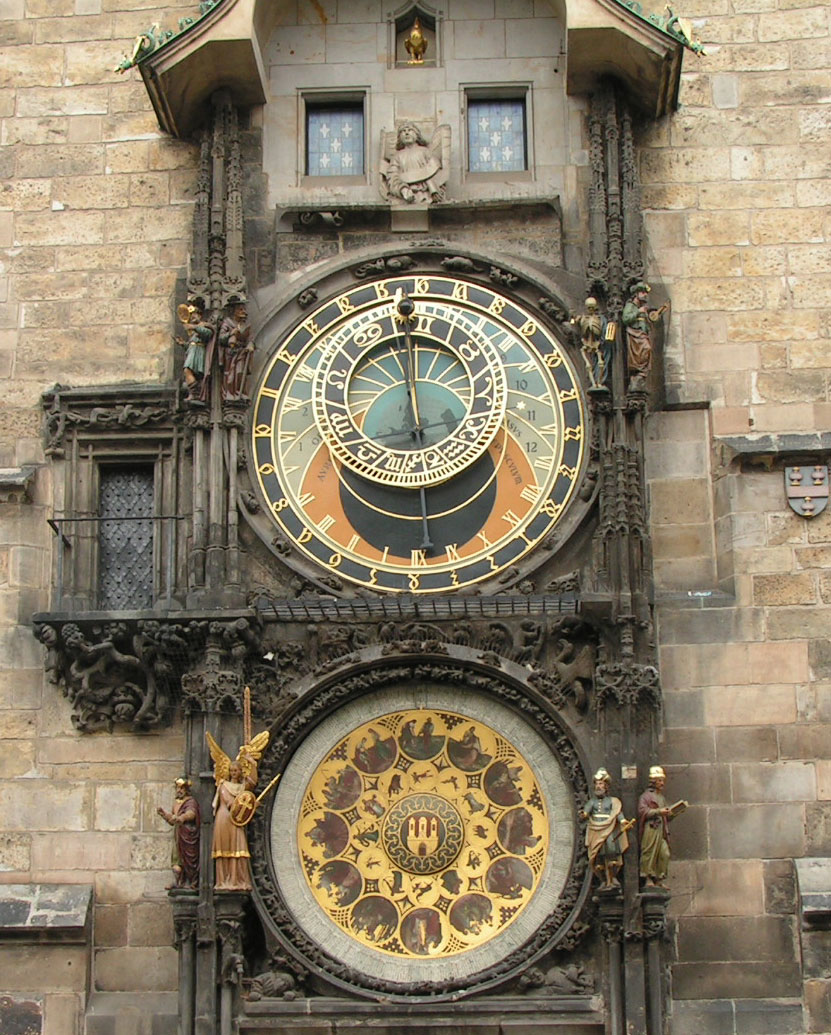 On our own the first two days in Prague we acquainted ourselves with the area around our hotel, including the shopping mall and restaurants. We were able to find our favorite cooling European snack, Magnum ice cream bars. This was fortunate, as once we left Prague we didn't find any the rest of the trip. The metro station was about a half block from our hotel, so we quickly learned our way to and around
Old Town Prague. We found an outdoor market a friend had told us about, and we also located the famous Astronomical clock that dates back to 1410 when it was made by clockmaker
Mikuláš of Kadaň and
Jan Šindel. Every hour the clock rings out as Christ and the twelve Apostles walk past two little windows above the clock face, then the skeleton of Death tolls the bell. On this photo the windows are closed and grey looking. We also found the Charles Bridge, spanning the Vltava River. We walked across the bridge from Old Town Prague to Malá Strana, or Lesser Town Prague as we listened to various musicians playing along the side of the bridge. There are 30 statues lining the span of the bridge, and Jane rubbed the statue of John of Nepomuk, which is said to bring good luck, though we don't know why, because On March 20, 1393 he was thrown into the river Vltava from the Charles Bridge at the command of Wenceslaus, King of the Romans and King of Bohemia. Later as we were having lunch al fresco we got caught in a rain storm...so much for the good luck. Upon returning to our hotel we met some of our fellow travelers at an orientation meeting.
On our own the first two days in Prague we acquainted ourselves with the area around our hotel, including the shopping mall and restaurants. We were able to find our favorite cooling European snack, Magnum ice cream bars. This was fortunate, as once we left Prague we didn't find any the rest of the trip. The metro station was about a half block from our hotel, so we quickly learned our way to and around
Old Town Prague. We found an outdoor market a friend had told us about, and we also located the famous Astronomical clock that dates back to 1410 when it was made by clockmaker
Mikuláš of Kadaň and
Jan Šindel. Every hour the clock rings out as Christ and the twelve Apostles walk past two little windows above the clock face, then the skeleton of Death tolls the bell. On this photo the windows are closed and grey looking. We also found the Charles Bridge, spanning the Vltava River. We walked across the bridge from Old Town Prague to Malá Strana, or Lesser Town Prague as we listened to various musicians playing along the side of the bridge. There are 30 statues lining the span of the bridge, and Jane rubbed the statue of John of Nepomuk, which is said to bring good luck, though we don't know why, because On March 20, 1393 he was thrown into the river Vltava from the Charles Bridge at the command of Wenceslaus, King of the Romans and King of Bohemia. Later as we were having lunch al fresco we got caught in a rain storm...so much for the good luck. Upon returning to our hotel we met some of our fellow travelers at an orientation meeting.
The next morning we went on a guided walking tour of Old Town, then stayed there for lunch and shopping before returning on the Metro to our hotel, where we would later join our tour group for dinner at the Lobkowicz Palace Cafe. This is located in the 16th century Castle of Nelahozeves, the Lobkowicz family chateau that is part of the Prague Castle complex. This area is also known as The Hradcany area,
or Castle District. The castle's entry is guarded by a sentry on either
side of the entrance, and the exterior courtyard offers a panoramic view
of Prague from atop the castle's hill. The style of this castle
represents the pinnacle of Renaissance Bohemian architecture and
features an extensive and varied art collection of the Renaissance
period to the late 1930s. It is one of the most important private
museums in Europe. The birth house of composer Antonín Dvorák is located on the castle complex.
This area is also known as The Hradcany area,
or Castle District. The castle's entry is guarded by a sentry on either
side of the entrance, and the exterior courtyard offers a panoramic view
of Prague from atop the castle's hill. The style of this castle
represents the pinnacle of Renaissance Bohemian architecture and
features an extensive and varied art collection of the Renaissance
period to the late 1930s. It is one of the most important private
museums in Europe. The birth house of composer Antonín Dvorák is located on the castle complex.
On our last day in Prague we toured the Castle District, including a tour of the interior of Prague Castle. This is a massive complex containing palaces, galleries, churches and museums. After lunch and a bit of walking around, we returned to our hotel to get ready for this evening's dinner in Sychrov Castle, which was built by the Rohans, thinking they were royalty, but they were not. In addition to being one of the famous historical buildings in Bohemia, this castle houses the largest collection of French portrait paintings in Central Europe. Upon our arrival we had a glass of champagne, then an organ concert accompanied by a songstress in the castle's chapel, followed by a tour of the Castle apartments and a typical Czech dinner in the Baroque Salon. This evening was a fitting end to our days in Prague. Tomorrow morning we would leave for a day long coach ride to Budapest.
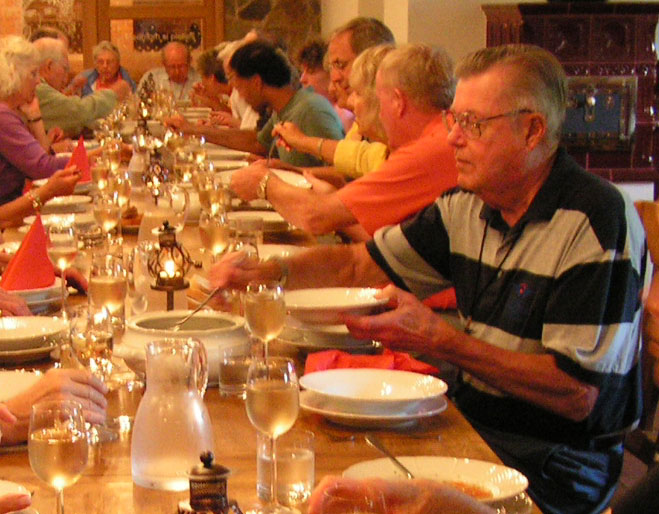 On our ride from Prague to Budapest we went through Bratislavia, Slovakia. We stopped for lunch in Modra, Slovakia, located in the Carpathian Mountains, at the Skolska Pivnica Wine School, which is associated with a wine school in the U.S. (whose name escapes me, and I didn't write it down...) Our lunch consisted of very good tasting goose soup, and then goose meat with potato "tacos". They were made with a potato base of some kind,
On our ride from Prague to Budapest we went through Bratislavia, Slovakia. We stopped for lunch in Modra, Slovakia, located in the Carpathian Mountains, at the Skolska Pivnica Wine School, which is associated with a wine school in the U.S. (whose name escapes me, and I didn't write it down...) Our lunch consisted of very good tasting goose soup, and then goose meat with potato "tacos". They were made with a potato base of some kind, 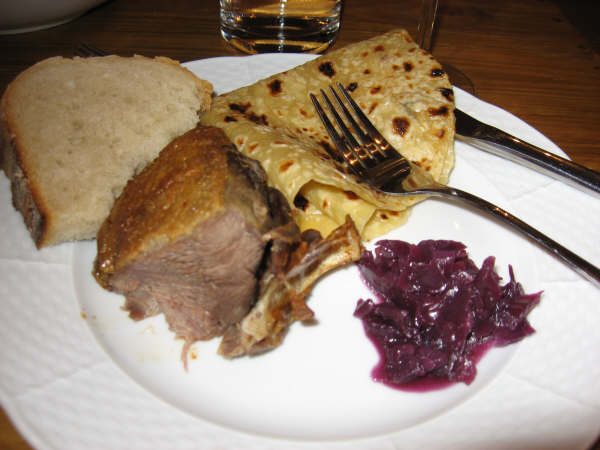 then cooked and folded over somewhat like pancake-consistency tacos, so we were laughing about the fact that we were having goose tacos for lunch. Thanks to Jacquie for the great photo! We continued on our journey to Budapest, arriving in time to settle in and learn our way around the hotel area.
then cooked and folded over somewhat like pancake-consistency tacos, so we were laughing about the fact that we were having goose tacos for lunch. Thanks to Jacquie for the great photo! We continued on our journey to Budapest, arriving in time to settle in and learn our way around the hotel area.
The next morning we had a city tour of Budapest, which is situated on both sides of the Danube River, with Pest (the right bank) being on the east, and Buda (the left bank) on the west side. In Pest we visited Heroes' Square then saw how absolutely huge the
Hungarian Parliament Building really is. We then crossed the river to the Buda side and walked around
Castle Hill, also known as Várhegy. This is a massive castle complex that was mostly destroyed during World War II, but the Royal Palace has been restored to its former beauty. Today it includes the Hungarian National Gallery, home to Hungarian art from the Midde Ages on. We had the rest of the day to roam on our own around Budapest. We chose to have lunch at a quaint outdoor cafe on our way to the farmer's market building, where we bought hand crafted magic boxes and Hungarian paprika, the best in the world. This evening we again had dinner at the Ba Bar Restaurant around the corner from our hotel, where they have delicous Hungarian goulash soup. Two nights in Budapest, two dinners at the Ba Bar... it WAS GOOD! We asked our server where the name Ba Bar came from and he said, "It came from the American story of the elephant." We can believe this or not, but it's cute that he would say that.
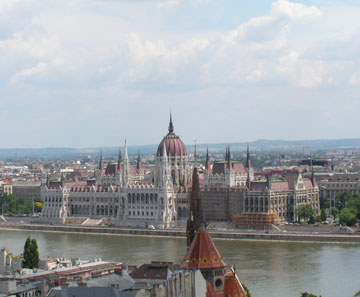 On our final day in Budapest we went to a Hungarian horse farm in the puszta, which means "an uninhabited place". This is an area of national parks and nature reserves with plains, pastureland, and marshes. We went to Lajosmizse, in the heart of the Great Hungarian Plain 70 kilometers south of Budapest, in central Hungary. Hungarian cowboys, called "csikos", are incredibly skilled, and they performed amazing demonstrations of showmanship and trust between man and horse. Our group was welcomed with apricot brandy (palinka), watched the horse show, then rode by horse-drawn carriages to a picnic area where we had a typical Magyar lunch under the trees while listening to a live band playing gypsy music. Our lunch was Hungarian goulash served out of a huge cast iron pot hanging over an open fire. We ate a lot of Hungarian goulash while in Hungary, and it was all different, and all delicious.
On our final day in Budapest we went to a Hungarian horse farm in the puszta, which means "an uninhabited place". This is an area of national parks and nature reserves with plains, pastureland, and marshes. We went to Lajosmizse, in the heart of the Great Hungarian Plain 70 kilometers south of Budapest, in central Hungary. Hungarian cowboys, called "csikos", are incredibly skilled, and they performed amazing demonstrations of showmanship and trust between man and horse. Our group was welcomed with apricot brandy (palinka), watched the horse show, then rode by horse-drawn carriages to a picnic area where we had a typical Magyar lunch under the trees while listening to a live band playing gypsy music. Our lunch was Hungarian goulash served out of a huge cast iron pot hanging over an open fire. We ate a lot of Hungarian goulash while in Hungary, and it was all different, and all delicious.
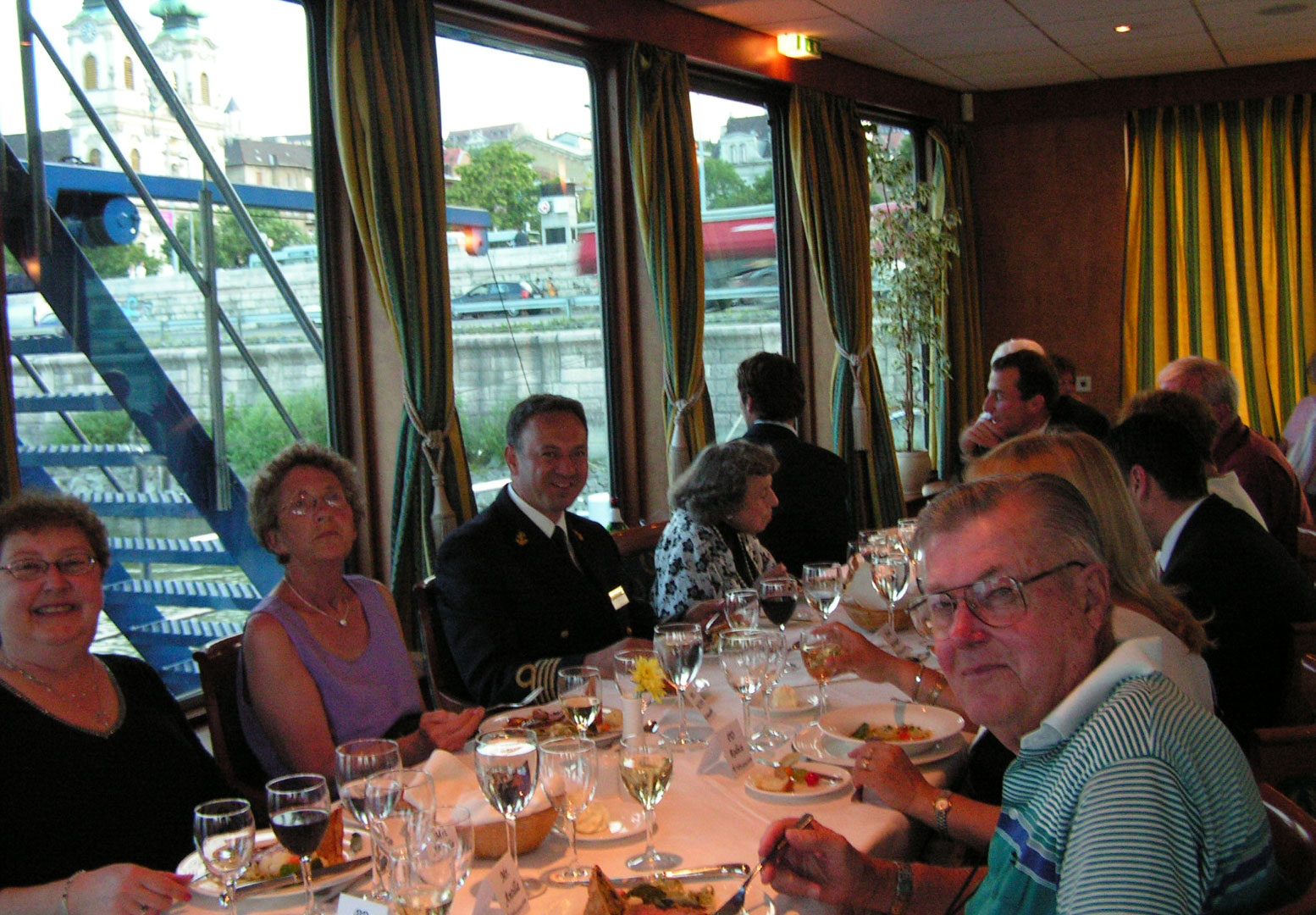 In the afternoon we embarked our riverboat, where we would live for the next several days while cruising the Danube to Constanta, Romania on the Black Sea, making stops at various towns along the way. This evening was the Captain's Dinner, and to our surprise we had a knock on our cabin door and were handed an invitation to sit at the Captain's table.
It was amazing. Each couple was escorted into the dining room to the
Captain's table, and each person had their own server. The serving staff
was synchronized to the second as they walked into the dining room and
at the same time set each course in front of each person at the
Captain's table. Following dinner we sailed a bit on the Danube, since the ship had to be turned around so in the morning we could sail in the direction we needed to go. Budapest at night is beautiful, with Castle Hill and the Parliament Building all lit up. We passed under the
Chain
Bridge, which when lit at night looks like a huge chain draping across the Danube, and at night one can see the lights and not much of the bridge structure itself. An interesting incident occured in 1800 at the time of the marriage of Joseph, then Palatine of Hungary and brother of the Austrian Emperor Francis. More than a thousand guests from Pest who had crossed the river on ice were trapped for several days in Buda when the
ice floes made it extremely dangerous to cross the river when the ice began to break up during the night. In 1820 bad weather forced Hungary's 19th century reformer,
Count István Széchenyi, to wait eight days before he could cross the river by ferry to attend his father's funeral.
In the afternoon we embarked our riverboat, where we would live for the next several days while cruising the Danube to Constanta, Romania on the Black Sea, making stops at various towns along the way. This evening was the Captain's Dinner, and to our surprise we had a knock on our cabin door and were handed an invitation to sit at the Captain's table.
It was amazing. Each couple was escorted into the dining room to the
Captain's table, and each person had their own server. The serving staff
was synchronized to the second as they walked into the dining room and
at the same time set each course in front of each person at the
Captain's table. Following dinner we sailed a bit on the Danube, since the ship had to be turned around so in the morning we could sail in the direction we needed to go. Budapest at night is beautiful, with Castle Hill and the Parliament Building all lit up. We passed under the
Chain
Bridge, which when lit at night looks like a huge chain draping across the Danube, and at night one can see the lights and not much of the bridge structure itself. An interesting incident occured in 1800 at the time of the marriage of Joseph, then Palatine of Hungary and brother of the Austrian Emperor Francis. More than a thousand guests from Pest who had crossed the river on ice were trapped for several days in Buda when the
ice floes made it extremely dangerous to cross the river when the ice began to break up during the night. In 1820 bad weather forced Hungary's 19th century reformer,
Count István Széchenyi, to wait eight days before he could cross the river by ferry to attend his father's funeral.
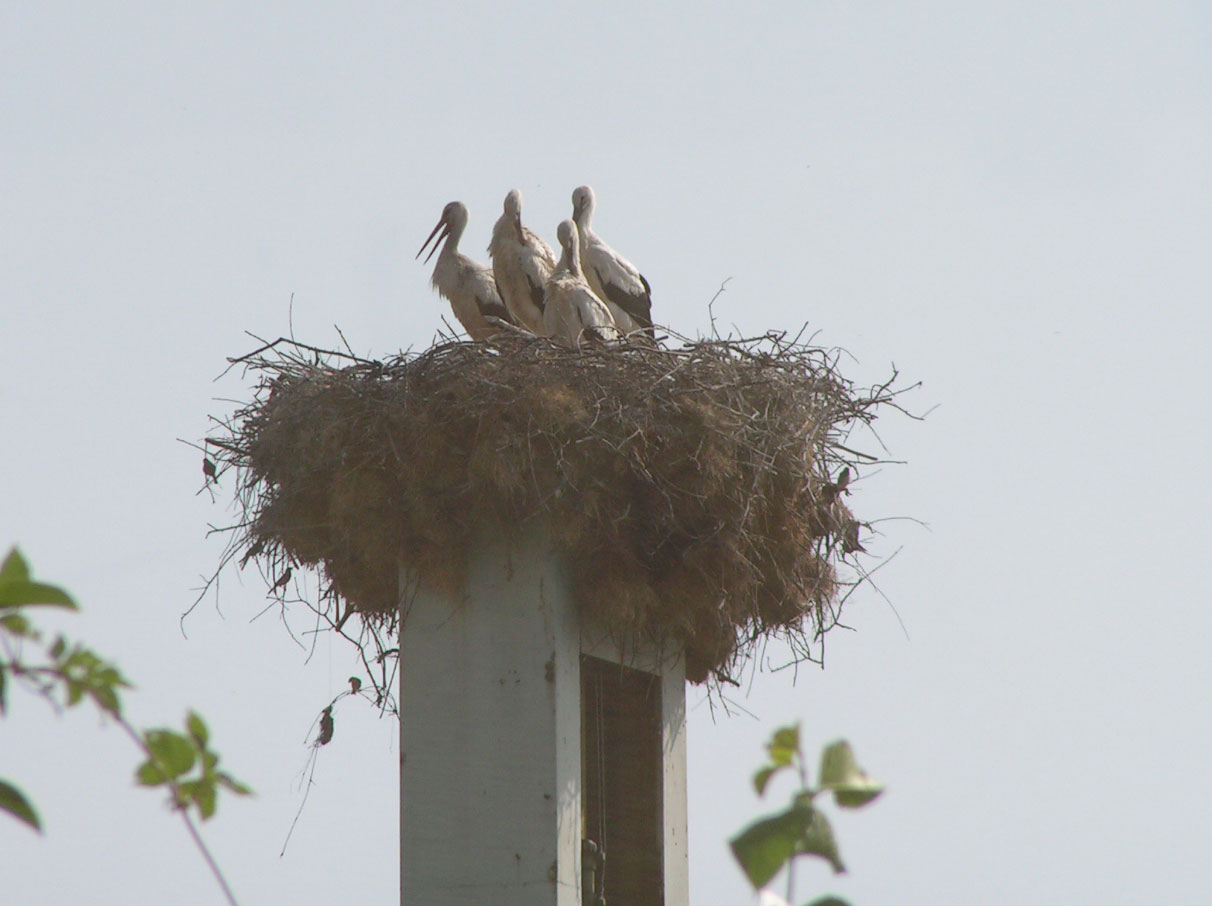 We spent the night on board our riverboat, and in the morning rode about twelve miles north of Budapest, to the town of Szentendre, where the Danube makes a sharp bend through the Pilis and Borzsony hills. Those who had not done the pre-trip option in Prague and Budapest had a city tour of Budapest this morning before we set sail later in the day for Vukovar and Osijek, Croatia.
We spent the night on board our riverboat, and in the morning rode about twelve miles north of Budapest, to the town of Szentendre, where the Danube makes a sharp bend through the Pilis and Borzsony hills. Those who had not done the pre-trip option in Prague and Budapest had a city tour of Budapest this morning before we set sail later in the day for Vukovar and Osijek, Croatia.
Vukovar is the site of the worst artillery shelling of the Croatian-Serbian war of 1991-1995. We walked through the town before going on to Osijek, the administrative and economic center of eastern Croatia. Osijek is on the Drava River, about 15 miles from the mouth of the Danube, in an area that was inhabited in pre-historic times, with the first urban settlement built by the Romans. It was destroyed by the Huns, rebuilt in the Middle Ages, destroyed by the Turks, and rebuilt in the 18th century. Because of this history, there is a variety of architecture in the buildings. After our walking tour we went in small groups to have lunch in local homes and learn about life in Croatia. Some of the homes in Osijek have stork nests atop their chimney, similar to what we saw in Strasbourg on a previous trip. A stork nest on your chimney is said to bring good luck, especially to newlyweds. After returning to our riverboat we set sail toward Belgrade, Serbia where we would spend the next day.
Belgrade is the capital of Serbia-Montenegro, one of Europe's oldest cities and the center of political and cultural life in the country. We toured the city and saw the old Town Hall, St. Sava Orthodox Cathedral, the largest Orthodox Cathedral in the world. We also saw the Kalemegdan Castle and Fort and the Tito Memorial, erected to honor
Josip Broz Tito. After lunch many of us chose to participate in a privilege that was once reserved for Marshal Tito when he was Yugoslavia's head of state: a ride on the historic Blue Train.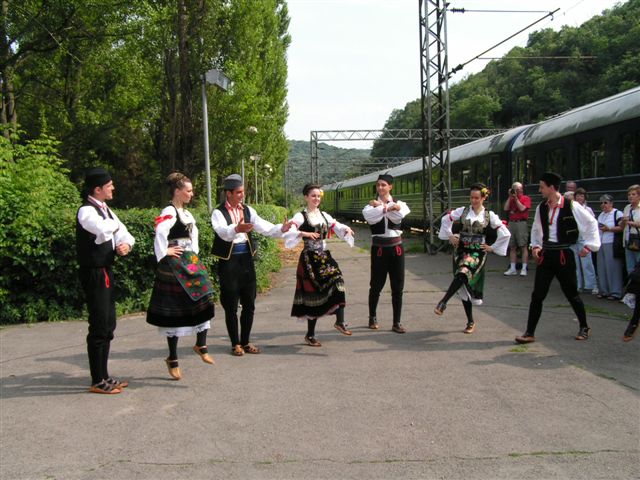 Prior to WWII this Blue Train was private transportation for the Serbian royal family, and in 1946 Tito began using it for his personal travel around Yugoslavia to bring his vision to cities along the rail route. He logged over 370,000 miles on it by 1980, and during those years top government officials and visiting foreign statesmen rode on it. After Tito's death this train took him on his final journey and carried his body across Yugoslavia to Belgrade. Some of the cars were refurbished for Queen Elizabeth, and during the talk about the train, the train guide offered Jane one of the chairs in the "meeting compartment", so she sat in the guest chair where France's President Mitterand, Queen Elizabeth and other foreign heads of state sat while conversing with Tito. In 2004 this historic train became available for the public to ride as a tourist attraction. We were treated to champagne and a folklore dance performance at the Topcider train station stop along the route through Belgrade.
Prior to WWII this Blue Train was private transportation for the Serbian royal family, and in 1946 Tito began using it for his personal travel around Yugoslavia to bring his vision to cities along the rail route. He logged over 370,000 miles on it by 1980, and during those years top government officials and visiting foreign statesmen rode on it. After Tito's death this train took him on his final journey and carried his body across Yugoslavia to Belgrade. Some of the cars were refurbished for Queen Elizabeth, and during the talk about the train, the train guide offered Jane one of the chairs in the "meeting compartment", so she sat in the guest chair where France's President Mitterand, Queen Elizabeth and other foreign heads of state sat while conversing with Tito. In 2004 this historic train became available for the public to ride as a tourist attraction. We were treated to champagne and a folklore dance performance at the Topcider train station stop along the route through Belgrade.
The next day was spent on board our riverboat as we cruised along a part of the Danube that was once a raging river pounding through deep gorges. In the 1960s there was a joint effort  by Yugoslavia and Romania that raised the level of the Danube with a series of hydroelectric dams called the Iron Gates The river is now tamed, with the amazing two-mile gorge now underwater. The views along this part of the Danube are spectacular, with fields and vineyards along its banks, with Romania on the north and Serbia on the south. We saw a huge face carved into rock on the left as we sailed. It was a relaxing day aboard our riverboat, a nice respite from the hectic schedule we were keeping.
by Yugoslavia and Romania that raised the level of the Danube with a series of hydroelectric dams called the Iron Gates The river is now tamed, with the amazing two-mile gorge now underwater. The views along this part of the Danube are spectacular, with fields and vineyards along its banks, with Romania on the north and Serbia on the south. We saw a huge face carved into rock on the left as we sailed. It was a relaxing day aboard our riverboat, a nice respite from the hectic schedule we were keeping.
We toured Veliko Tarnovo and Arbanassi, Bulgaria the next day. Veliko Tarnovo was the capital of Bulgaria from 1186 to 1394 and is located high on hills overlooking the Yantra River. We saw the fortified wall of
Tzarevez Hill. Arbanassi is an architectural reserve and one of the most historic villages in Bulgaria, with more than 80 houses, several churches, and two monasteries built in the 17th and 18th century style. We had a delicious lunch in a local restaurant that served us one of the best salads we've had, consisting of cucumber, tomatoes, crumbled sheep cheese and sunflower oil.
Early the next morning we entered the Black Sea Canal and continued cruising toward Constanta, Romania's main port. This is a 40-mile waterway, one of the most important commercial links in Eastern Europe. It was a 6th century BC Greek colony, a Roman outpost in the 1st century AD, and a Soviet port in the late 20th century. We toured the old city and port area and the National History and Archaeological Museum, then went wading in the Black Sea. Last summer Jane had her toes in the North Sea, and this summer she waded in the Black Sea, which was a tad warmer... In the morning we would disembark our riverboat and ride a private train through the Romanian countryside to Bucharest, where some of us would continue on to Sinaia, in Transylvania, for the next four days. One interesting but not-fun-to-find-out fact on this train ride was that when using the restroom, we girls noticed that the toilets are open to the ground, thus "everything" goes onto the track. Our initial reaction was to laugh quite hysterically about this when the first of us discovered it, then realized how unsanitary it is and stopped laughing.
Last summer Jane had her toes in the North Sea, and this summer she waded in the Black Sea, which was a tad warmer... In the morning we would disembark our riverboat and ride a private train through the Romanian countryside to Bucharest, where some of us would continue on to Sinaia, in Transylvania, for the next four days. One interesting but not-fun-to-find-out fact on this train ride was that when using the restroom, we girls noticed that the toilets are open to the ground, thus "everything" goes onto the track. Our initial reaction was to laugh quite hysterically about this when the first of us discovered it, then realized how unsanitary it is and stopped laughing.
We weren't sure what to expect of the Transylvania area, though we had been told by friends who had been there that it was beautiful, and they were right! The countryside is filled with mountains, rivers, streams, lots of blue sky and a sub-Alpine climate, which was very welcome after the heat wave we experienced the first two weeks of our trip. We stayed in
Sinaia, which is one of the most famous resort destinations in Eastern Europe and is known as "the Pearl of the Carpathians". We took a short walk up the hill behind our hotel to a ski lift, bought tickets and rode up to the first stop at 1400 meters. We didn't have time to go to the top, as the last ride down was too soon and we didn't want to get left at the top overnight - we had too much to see and do the next day.
It was a dark and stormy morning when we had a tour of the famous Bran
Castle, Prince Vlad Tepes, son of Vlad Dracul and the person who inspired Bram Stoker's 1897 novel 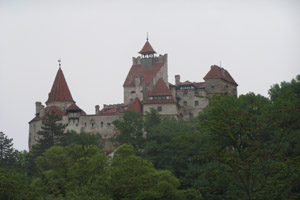 often referred to as Dracula's Castle.
Dracula used this castle as headquarters for his visits to Transylvania. Bran Castle was built in 1377 to protect nearby Brasov from invaders, and also was a customs station. This castle has a lot of history, which can be found by clicking on the link above.
often referred to as Dracula's Castle.
Dracula used this castle as headquarters for his visits to Transylvania. Bran Castle was built in 1377 to protect nearby Brasov from invaders, and also was a customs station. This castle has a lot of history, which can be found by clicking on the link above.
We were told by our program director that Peles Castle is the most beautiful in all of Europe. We've seen many wonderful castles, including those in Loire Valley in France, and found it difficult to believe this was better. One look inside, and we knew he was right! It sits dramatically in the hills above Sinaia and has 160 rooms built in Neo-Renaissance style. It was completed in 1914 for the first Hohenzollern king of Romania, King Carol I, and was his attempt to imitate the styles of his former homeland, creating a Bavarian setting in the mountains of Romania. It is decorated inside and out with intricate woodcarvings and paintings of scenes from Wagner's operas, is one of the best-preserved royal palaces in Europe and, unlike many other castles and palaces we've seen, is fully furnished. We were so impressed that we bought a book about this castle so we would have photos of its interior. After our tour we had lunch at the Restaurant
Sirul Vamii in Brasov the largest city in Transylvania. Brasov has been continuously occupied since the Bronze Age. Following lunch we had time to shop in Brasov before returning to our hotel. We had a leisurely dinner near our hotel and rested up for another busy day.
This evening we went to the Rhein Azuga Cellars for a tour of the winery, sparkling wine tasting and dinner. This was our last day in Transylvania, and the next morning we would ride by motorcoach to
Bucharest, the capital of Wallachia, and then Romania since 1659.
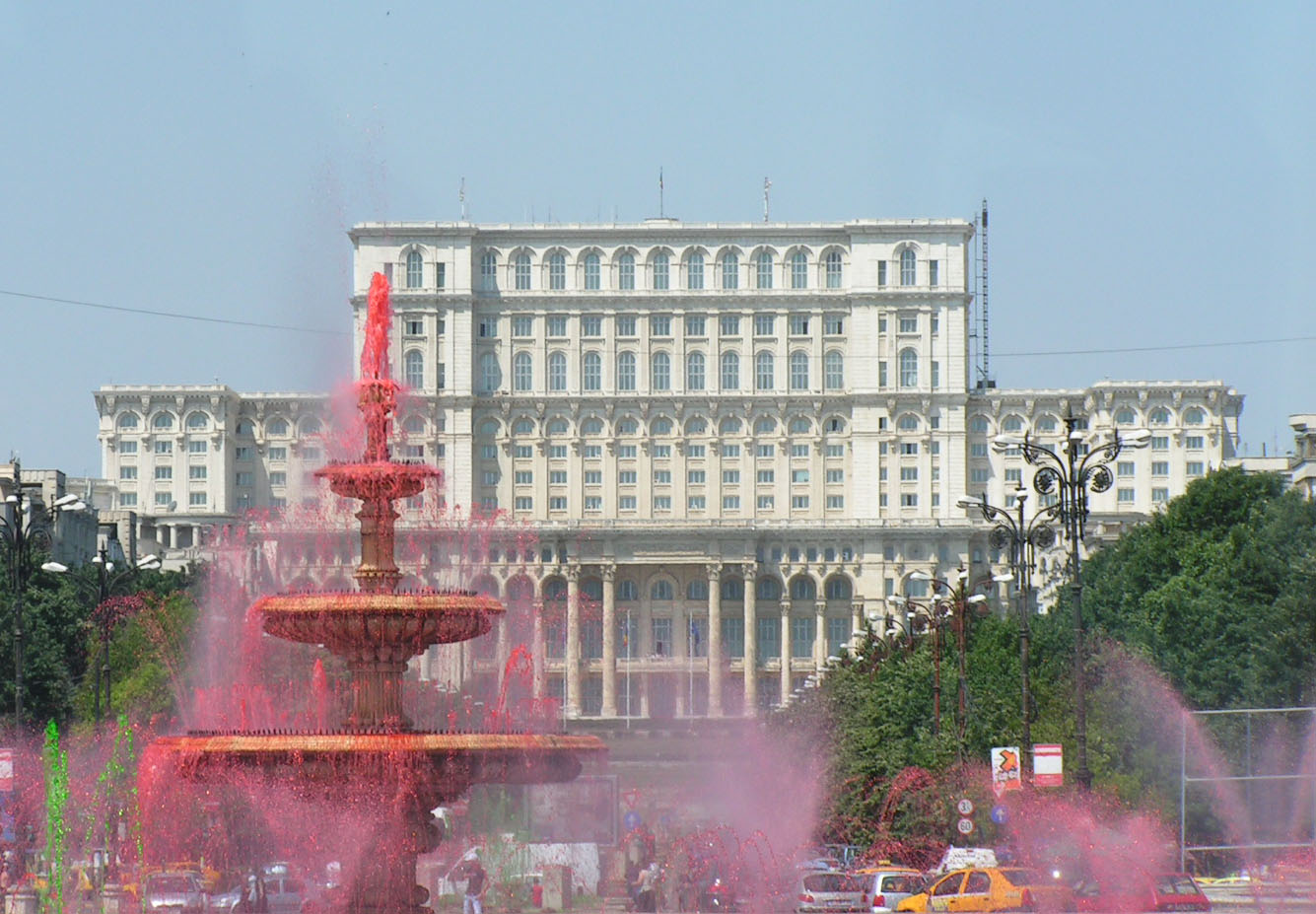 Today Bucharest is often called the "Little Paris" because of its wide boulevards. On a city tour we saw the Arc de Triomphe that commemorates the World War I soldiers and then rode along victory Avenue to Revolution Square. We viewed the
Ceausescu Palace, which is the second largest building in the world, second to our Pentagon. We were told there is more of the building underground than above, which is difficult to imagine because it is so massive above ground. This photo was taken from several blocks away, as I could not get the whole building in if taken closer. After our tour we settled in and walked a few blocks to where there was a market along the river. We had lunch at an outdoor restaurant with some of our tour friends and walked around a bit. The next day we indulged ourselves and slept in a bit before having a late breakfast and organizing our belongings and trip purchases so we could pack for home. We had a group farewell dinner with dancing and music at an outdoor restaurant and went to bed early, as we had a VERY early wake-up call to get to the airport the next morning.
Today Bucharest is often called the "Little Paris" because of its wide boulevards. On a city tour we saw the Arc de Triomphe that commemorates the World War I soldiers and then rode along victory Avenue to Revolution Square. We viewed the
Ceausescu Palace, which is the second largest building in the world, second to our Pentagon. We were told there is more of the building underground than above, which is difficult to imagine because it is so massive above ground. This photo was taken from several blocks away, as I could not get the whole building in if taken closer. After our tour we settled in and walked a few blocks to where there was a market along the river. We had lunch at an outdoor restaurant with some of our tour friends and walked around a bit. The next day we indulged ourselves and slept in a bit before having a late breakfast and organizing our belongings and trip purchases so we could pack for home. We had a group farewell dinner with dancing and music at an outdoor restaurant and went to bed early, as we had a VERY early wake-up call to get to the airport the next morning.
Though we enjoyed this trip, it was difficult looking at all the bombed-out buildings and cannon holes in the walls as we rode through various cities and towns of Croatia. Few repairs have been done, and many buildings are as they were at the end of the Croatian War of Independence from 1991 to 1995.
We're unsure what our next destination will be, but we are perusing the mountain of travel catalogs that fill our mailbox. We hope you enjoyed your virtual tour of Eastern Europe.